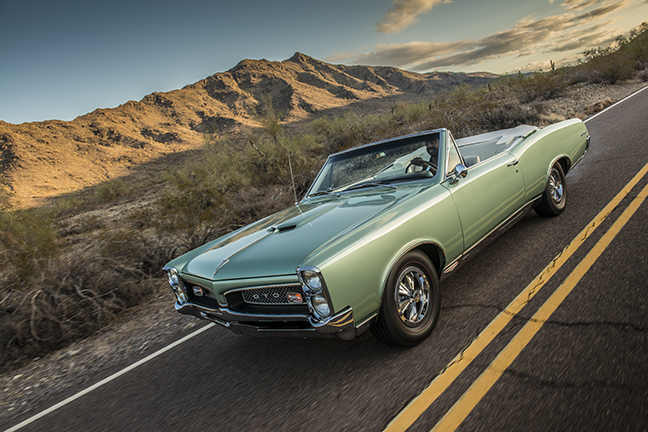Pontiac GTO 50th Anniversary: Ghost of “The Goat” Still Haunts Detroit – and Stuttgart, Too
Happy 50th anniversary, Pontiac GTO! It’s too bad the Pontiac brand isn’t still around to celebrate, but there are legions of proud GTO owners and muscle car buffs who treasure the model that launched the muscle car genre.
The GTO history has been told too many times to count, so this feature will not add to the pile. Rather, it’s worth looking back at the impact the GTO made, not only on car enthusiasts, but also on the auto industry. The GTO’s influence continues today in ways and on cars that you might not suspect.
Let’s get a key issue out of the way. When discussing the GTO’s place in auto history, it’s safer to say, “Launched the musclecar genre” than “It was the first muscle car.” As Chevy, Ford and Mopar fans could correctly point out, several models that preceded the 1964 GTO offered performance to qualify as a muscle car. All any of those cars would prove, however, is that Detroit had already been catering to the performance enthusiast, albeit in very small numbers, and without crafting specific model identities. (The Chevy Impala Super Sport with one of the 409 V-8’s could certainly be considered an exception.)
What changed in late 1963, when the GTO arrived as a performance option for the 1964 Pontiac Tempest LeMans? That’s the year that the 3.4 million kids born in 1946, the first wave of “baby boomers,” turned 17. Clever marketing would prove every bit as valuable as engineering in reaching this group.
These buyers wanted more than fast quarter-mile times. They wanted to stand out at the drive-in and the burger drive-through. They wanted a car that reflected their self-image, a car with the look and sound of performance, not just impressive acceleration figures.
Pontiac had set the stage for a car to fill that niche, with its racing successes and clever promotion over the previous few years. The challenge was parlaying that into a showroom model that would appeal to young buyers, while still being affordable to them. Engineering was the easy part. Pontiac’s V-8, whether in 326- or 389-cubic-inch displacement, used the same block. So, the “bigger” engine was a bolt-in to the midsize Tempest body.
The ’64 GTO was quick, with mid-15-second quarter-mile times in standard 325-horsepower trim. It was affordable, too, with a starting price of just over $2,800. A choice of post coupe, hardtop coupe or convertible styles ensured wide appeal.
It didn’t take much to create the GTO’s street image – dummy hood scoops, redline tires, and some special exterior and interior trim did the job. Crucially, the GTO could be personalized with a plethora of performance, comfort and appearance options, including the Tri-Power triple-carburetor intake.
Above all, the GTO had a brazen, youthful attitude lacking in other cars. Perhaps most brazen was Pontiac’s “borrowing” the Gran Turismo Omologato name from the renowned Ferrari racecar. It all added up to a virile image that resonated with the car’s primary target buyer group, 18- to 25-year-old men.
Pontiac sold some 32,000 1964 GTOs, three times as many as projected. The instant success for what was a separate option package that first year vindicated Pontiac’s 40-year-old chief engineer, John DeLorean, who just barely pushed the car through corporate approval as a $296 option package. The GTO’s success also boosted the stature of marketing man Jim Wangers, whose clever marketing helped make the GTO more than just a sales success, but a pop culture icon, too.
“Brazen” would describe the marketing tactics Wangers employed to generate buzz for the GTO. Swapping a specially prepared 421-cubic-inch engine into Car & Driver’s road test car to achieve a blistering 12.8-second quarter mile was surely the most audacious. Wangers kept the high-profile GTO promotions and tie-ins coming, helping boost GTO sales to 75,000 for 1965 and higher for several years afterward. It was a harbinger of automotive marketing to come.
The subtext that the GTO could help young men attract attention from young women was ever present in the car’s marketing. Pontiac underscored that message by having America’s most eligible fictitious bachelor, astronaut Anthony Nelson, drive a GTO in TV’s “I Dream of Jeanie,” which debuted in the fall of 1965.
While other GM divisions introduced GTO competitors starting in 1965, Ford didn’t enter the race until the 1966 Fairlane GT. Chrysler was even slower to respond, finally combining high-performance and street image with the 1967 Plymouth GTX and Dodge Coronet R/T and then achieving much more success with the 1968 Plymouth Road Runner.
The Chevelle SS 396 and the Plymouth Road Runner passed the GTO in sales and street image, and Pontiac was rightly accused of allowing its muscle car to atrophy. The defunct division deserves some credit, however, for having fielded a kind of “grown-up” muscle car with the 1973 Grand Am, essentially a more luxurious take on the GTO concept.
The original GTO’s lasting legacy might just be today’s youth-oriented versions of otherwise mundane cars, such as the Volkswagen GTI and Honda Civic Si. Even the $60,000 Mercedes-Benz C63 AMG follows the GTO formula: install a bigger, more powerful engine, tweak the chassis, dress up the body and interior with special trim, and market accordingly.
Even if the results are technically superior, the blueprint remains the same as the GTO made famous 50 years ago.


